Content
Brunner large-leaved is an ornamental plant that is distinguished by large oval or heart-shaped leaves with beautiful patterns. It is very easy to grow a culture, the bush requires practically no maintenance. The only important condition is abundant, regular watering.
Where does brunner large-leaved grow
Brunner large-leaved (Brunnera macrophylla) is also called forget-me-not. Under natural conditions, it grows in warm regions with subtropical and subequatorial climates:
- Caucasus;
- Transcaucasia;
- Southeast Asia.
This is a perennial bush from the genus of the same name, the Borage family. He is undersized, up to 50-60 cm in height. Leaves with long petioles are rounded, up to 15-20 cm in diameter, which is why the plant got its name. The flowers are similar to classic forget-me-nots (they are small, blue, with five petals), but the spot is not yellow, but white. At the same time, it is the leaves, not the flowers, that give the large-leaved brunner a special decorative effect.
Varieties
In the Burachnikov family, 3 species of brunner are known. At the same time, much more varieties have been bred. Despite the fact that this is a heat-loving plant, the breeders managed to achieve the necessary winter hardiness. Thanks to this, large-leaved brunner can be grown in most regions of Russia.
Millennium Zilber
A small bush with beautiful light green leaves. A distinctive feature is white spots, against which the veins contrast well, creating an interesting relief effect. According to the growing conditions, this large-leaved Brunner variety is unpretentious.
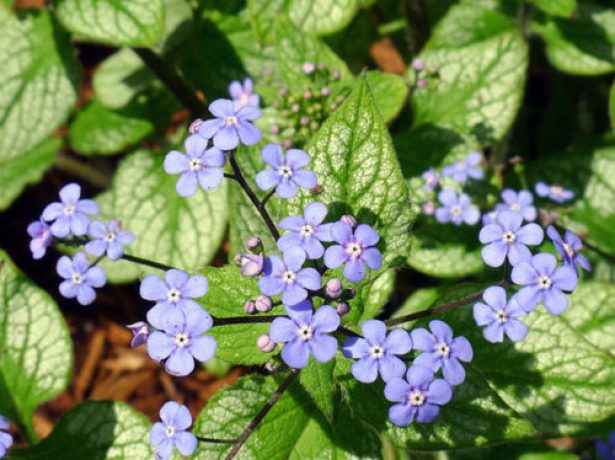
Millennium Zilber prefers light soils, shading and abundant watering
Jack Frost
An original variety of large-leaved brunner with silvery, frosty leaves and classic blue flowers. The bush is quite tall, reaching 60 cm in height. It is distinguished by good winter hardiness, withstands frosts down to -40 ° C, which allows it to be bred almost throughout Russia.
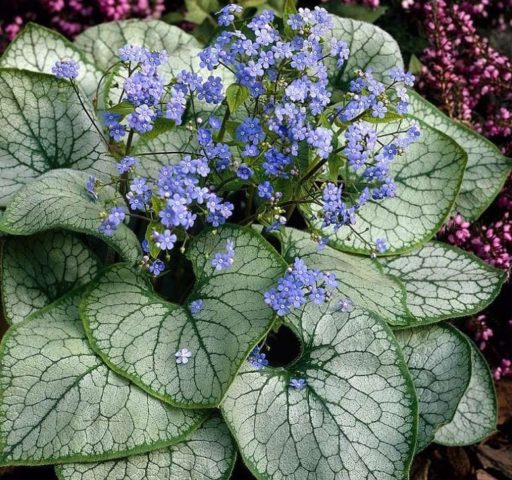
Large-leaved Brunner variety Jack Frost prefers light shading, abundant moisture
If the moisture supply stops, the leaves begin to droop almost immediately. Active foliage growth is observed on fertile soils, well fertilized with manure. It is in this case that Brunner is able to decorate the site from mid-spring to late autumn.
Hudspan Cream
A bush with large leaves, heart-shaped, light green color, creamy yellow edges. A pattern is often visible on the surface: the border invades the center of the sheet, drawing different patterns. This Brunner variety blooms from May to June. It grows in height only up to 30 cm, so it is better to combine it with low-growing plants - various host species, petunias, Iberis, Alpine asters, rays and many others.
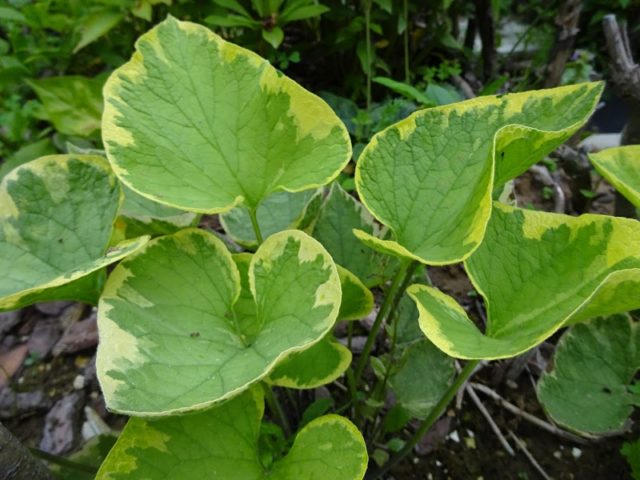
The Hudspan Cream variety has an average winter hardiness, so it can be grown in the regions of Central Russia and in the south.
Langtries
A low-growing shrub that grows up to 40 cm in height. The leaves are oblong, have long petioles and a pointed tip. They are painted in a deep dark green color, have specks of a silvery shade, reminiscent of frozen raindrops. The large-leaved brunner blooms from the end of May (about 3-4 weeks). The second bloom begins in late September or early October if a warm Indian summer is established.
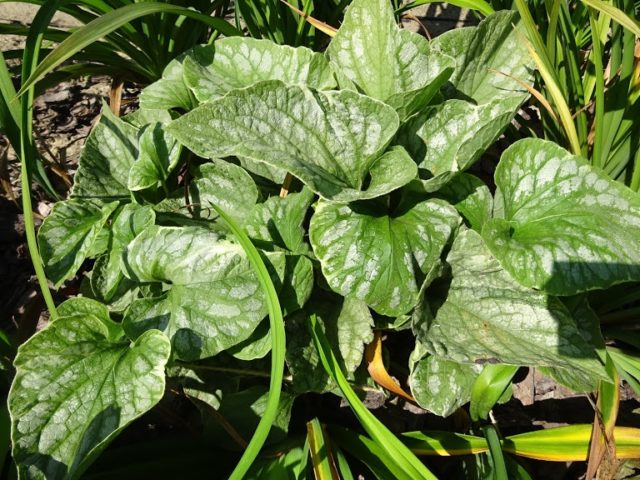
Brunner Langtries bush is unpretentious, winter-hardy enough, compact and does not grow
Such a plant can be used in mixborders, borders and rockeries. It will not interfere with neighboring flowers and will fit well even in a small flower bed.
Otherwise, the greenery will begin to stretch, and the bush will lose its decorative effect.
Variegata
One of the most beautiful varieties of large-leaved brunner is variegata. The bushes can be easily recognized by the leaves of a rich green color with a rather wide, uneven border of cream color. The flowers are small and bright blue.
This variety of large-leaved brunner is very winter-hardy (zone 3), withstands frosts down to -40 ° C. Therefore, it can be grown not only in the central part, but also in Siberia and the Urals. The bush is compact, therefore 1 m2 you can place up to 9 plants. Prefers partial shade, therefore it is great for decorating the trunk circle, in single and group plantings.
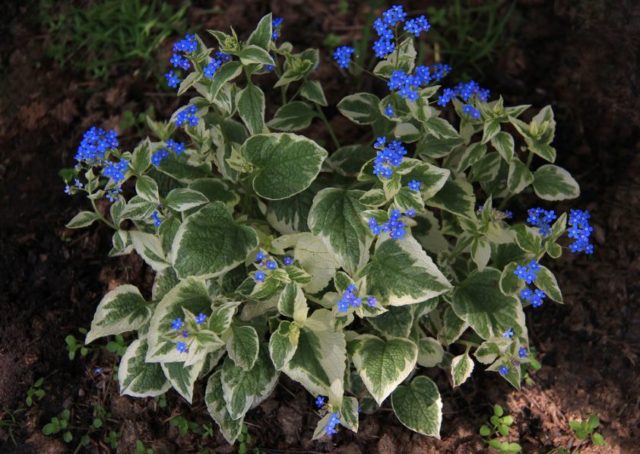
The flowering period of Brunner Variegata - May-June
Growing from seeds
Brunner large-leaved can be grown from seeds, but this method is rarely used because:
- The seeds are small and difficult to work with.
- Before planting seedlings in spring, they require long-term stratification.
- The seeds ripen for a very long time, so in some regions it will not be possible to wait for their formation.
- Brunner is easier to propagate by dividing the rhizome. If grown from seeds, the bushes will bloom in 3 years.
However, you can grow a large-leaved brunner bush yourself. Most often, the seeds are sown in the fall, at the beginning of October. The site is pre-cleaned, dug up, wood ash or a mixture of superphosphates with potassium salt is added. They are laid out on the surface, sprinkled with earth, watered, mulched. The first shoots will appear next year.
Seedlings of large-leaved brunners are grown at home. At the same time, it is also necessary to start working with seeds in the fall. They are stratified within three months: they are laid out in a cup with moistened vermiculite, sphagnum or perlite. Then cover with foil and put in the refrigerator. Periodically make sure that the "soil" does not dry out.
In mid-March, the seeds of the large-leaved brunner are planted on seedlings. To do this, you can use cassettes, peat pots, cassettes and other containers. The soil is bought in a store or made up independently, for example, from turf soil with compost and humus in a ratio of 2: 1: 1.
Seedlings of large-leaved brunners are first grown in greenhouse conditions (temperature 25 ° C, under the film). After 10-15 days, the film is removed and the temperature is lowered to room temperature. Liquid complex fertilizer is applied every 2-3 weeks. Brunner seedlings are transferred to open ground in early July (it is undesirable to plant a plant in spring). They can be pre-hardened at a temperature of 15-18 ° C.
Landing
One of the features of the large-leaved brunner is that it is planted not in spring, but in the second half of summer. The fact is that in the spring the bushes are susceptible to various diseases, so it is better not to risk it.
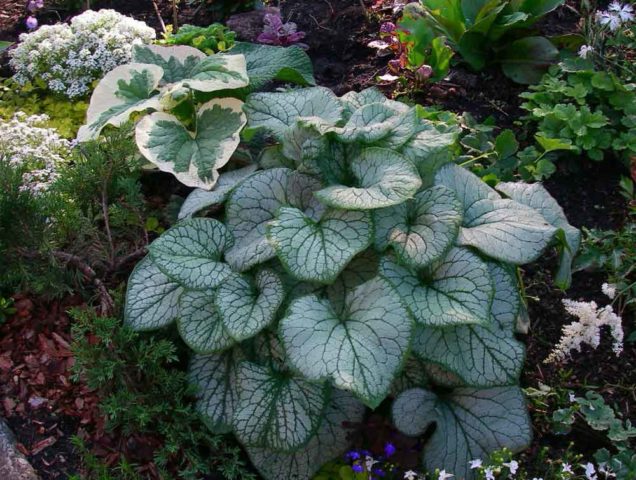
Brunner large-leaved prefers shaded areas
Site selection and preparation
Almost all Brunner varieties need shade and moisture, so it is optimal to place the crop under a large tree or next to a taller shrub (in the trunk circle). It is not scary if the site is located in a lowland, however, prolonged stagnation of moisture is also undesirable.
The site should be prepared several weeks before planting. It is cleaned and dug up. If the soil is depleted, it is fertilized with humus and complex mineral fertilizer at the rate of 50-60 g per 1 m2... An alternative way is to sprinkle a few pinches of wood ash with sand.
Planting stages
Planting instructions are standard:
- Several holes are formed, the depth of which corresponds to the rhizome. The interval between them should be 30-40 cm. A less tight fit is also allowed - it all depends on the design features.
- If the soil has not been fertilized, it is necessary to make a fertile mixture of turf soil with humus, or add a tablespoon of superphosphate and potassium salt to each hole, mixing them with the soil.
- The rhizome of large-leaved brunners is sprinkled with soil and watered abundantly.
- To keep the soil moist as long as possible, be sure to lay a layer of mulch (peat, hay, straw, spruce branches).
Care
Brunner's care is very simple, but it has several features:
- Watering should be regular and abundant. The soil should not dry out, let alone crack. It is optimal to use settled water at room temperature.
- It is undesirable to loosen the soil, since the roots of the large-leaved brunner lie at the surface.
- The plant does not need feeding. In early spring, you can place a few complex fertilizer granules right on the snow.
- Brunner is rarely transplanted to a new place. Experienced gardeners grow it without transplanting for 12-15 years.
Diseases and pests
Since Brunner needs good hydration, she often suffers from fungal diseases:
- powdery mildew;
- brown spot.
Periodically, the bush should be inspected for spots, white bloom and other extraneous formations. If they are found, all affected foliage is immediately cut off and thrown away from the site or burned.
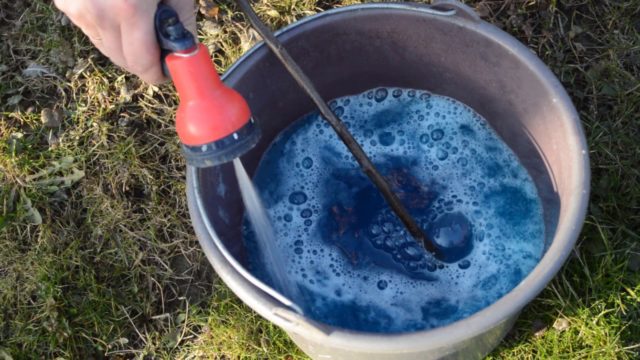
They are treated with any fungicide: Bordeaux liquid, Tattu, Profit, Fitosporin or others
Also whiteflies and aphids often parasitize on the large-leaved brunner. They are removed manually or sprayed with an insecticide (Biotlin, Decis, Confidor, Aktara). You can also use folk remedies - a solution of baking soda, an infusion of onion peels, chopped cloves of garlic and others.
Pruning
Pruning large-leaved brunners recommend doing 3 times:
- After the end of flowering, all peduncles are removed. The fact is that the plant spends a lot of energy on the formation of fruits, therefore, decorativeness decreases.
- Before the start of the second wave of flowering, large-leaved brunners pluck all the buds.
- After the first frost (October - November), remove all leaves and shoots at the root (leave the stems at a height of 4-5 cm).
Preparing for winter
Almost all varieties of large-leaved brunners tolerate frosts well, since they are highly winter-hardy. Therefore, they do not need special preparation for the winter period. In October, the bushes can be watered abundantly, and then mulched with compost, peat, humus, fallen leaves.
Reproduction
Along with the seed method of reproduction, the large-leaved Brunner is also bred by dividing the bush. The procedure begins after the end of flowering - this can be July or August. An adult bush (at least 3 years old) is dug up and cut with a knife into several divisions so that 2-3 healthy shoots remain on each of them. Then they are planted in a permanent place according to the same algorithm.
Conclusion
Brunner large-leaved - a plant that can decorate a garden, especially a tree trunk circle, nondescript corners. With it, you can create a composition in a rock garden or rockery. The culture is unpretentious, does not even require feeding. Therefore, any gardener can cope with the cultivation of a brunner.








